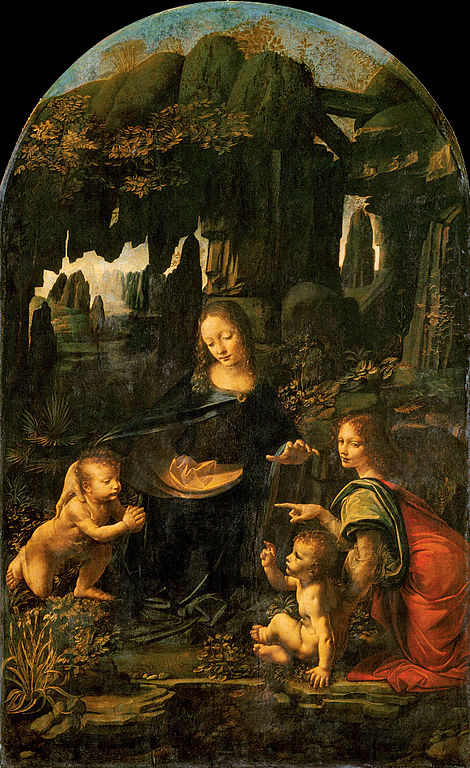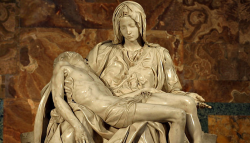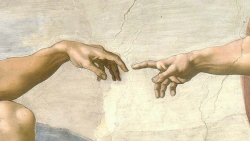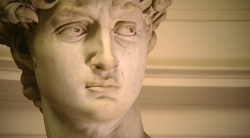In April of 1483, the Confraternity of the Immaculate Conception commissioned Leonardo to paint the Virgin of the Rocks as part of an altarpiece for its chapel in the church of San Francesco Grande in Milan. The painting was done on a wooden panel which was meant to be placed within a larger sculpted altarpiece for the chapel. Oil paints were used for the pigments. At this time in the late fifteenth century, oil was still a new medium which had only recently been adopted by Italian painters. It had been used with much success for decades by painters in northern Europe, such as Jan van Eyck and Rogier van der Weyden, who were able to capture detail on a microscopic level and convey a sense of realism that was unattainable using other types of pigment. Now that oil paints had arrived in Italy, Leonardo was able to use them to great advantage to create the Virgin of the Rocks, one of the great early masterpieces using this media in the Italian peninsula.
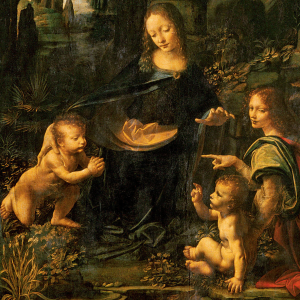 For the painting’s composition, Leonardo placed several figures in a basic pyramidal arrangement. The placement of figures in this way reflected the typical approach taken by other Renaissance artists working in the pictorial arts, such as Lorenzo Ghiberti in his competition panel for the bronze doors of the Florence baptistery, and Masaccio in the Holy Trinity fresco in the side chapel of Santa Maria Novella in Florence. Here, the patrons had requested that Leonardo include the Virgin Mary, the Christ Child, and at least one angel, but in order to give better balance to the scene Leonardo included the figure of John the Baptist as well.
For the painting’s composition, Leonardo placed several figures in a basic pyramidal arrangement. The placement of figures in this way reflected the typical approach taken by other Renaissance artists working in the pictorial arts, such as Lorenzo Ghiberti in his competition panel for the bronze doors of the Florence baptistery, and Masaccio in the Holy Trinity fresco in the side chapel of Santa Maria Novella in Florence. Here, the patrons had requested that Leonardo include the Virgin Mary, the Christ Child, and at least one angel, but in order to give better balance to the scene Leonardo included the figure of John the Baptist as well.
The identification of the child figures may be confusing to the modern viewer in part because they are not accompanied by obvious iconographic clues revealing their identifies. The figure on the left is St. John, and the figure seated on the right is Christ. Adding to this confusion is the fact that not only is the Christ Child not seated in the Virgin’s lap, but she is not even touching her son. Instead, her hand is on the back of St. John, who knees in adoration toward his cousin. Christ, in turn, blesses St. John.
The gestures and glances among the figures results in a more dynamic portrayal of the Virgin and Child that seen in earlier Renaissance paintings. Whereas a painting such as Masaccio’s Holy Trinity showed figures which related to one another to a limited degree, Leonardo has created a scene in which all the figures interact through gestures and glances to create a more unified whole. The angel on the right glances out at the viewer while pointing at St. John, whose gaze toward Christ provides a main focal point of the painting. The Virgin also gazes down at her son, and the placement of her left hand reinforces the emphasis on Christ. The connection between the Virgin and St. John is then made by the placement of her right hand. Thus, although the pyramidal composition is something that had been employed by Renaissance artists for decades, the way Leonardo made all the figures interact in a naturally-engaging way is different.
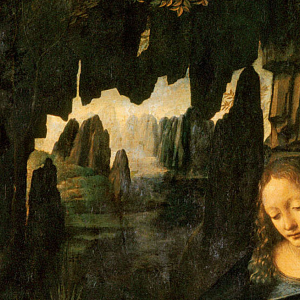 In addition to the dynamism of the figural group, the Virgin of the Rocks is also noteworthy for its rocky, almost mysterious setting in which the figures are placed. It is not the type of heavenly space symbolized by the golden background of older altarpieces, such as those by Cimabue, Giotto, or Duccio. Nor is it an idealistic landscape that can be found in Fra Filippo Lippi’s painting of the Virgin and Child. Instead, it is dark, misty, and cavernous. On the left side in the distance, the forms become less distinct as they get lost in a haze of foggy atmosphere, which illustrates the implementation of aerial perspective. The very smooth transition between colors and between light and dark that Leonardo used in this painting is called sfumato, which means “smoky”. Not only is it visible in the landscape, but also in the figures, who are cast in light which smoothly turns into areas of dark shade. It is similar to the traditional chiaroscuro technique used by earlier Italian painters, but it is more refined and elevated to convey a higher level of visual realism.
In addition to the dynamism of the figural group, the Virgin of the Rocks is also noteworthy for its rocky, almost mysterious setting in which the figures are placed. It is not the type of heavenly space symbolized by the golden background of older altarpieces, such as those by Cimabue, Giotto, or Duccio. Nor is it an idealistic landscape that can be found in Fra Filippo Lippi’s painting of the Virgin and Child. Instead, it is dark, misty, and cavernous. On the left side in the distance, the forms become less distinct as they get lost in a haze of foggy atmosphere, which illustrates the implementation of aerial perspective. The very smooth transition between colors and between light and dark that Leonardo used in this painting is called sfumato, which means “smoky”. Not only is it visible in the landscape, but also in the figures, who are cast in light which smoothly turns into areas of dark shade. It is similar to the traditional chiaroscuro technique used by earlier Italian painters, but it is more refined and elevated to convey a higher level of visual realism.
This painting is one of Leonardo’s early masterpieces, and it shows his reliance on traditional Italian Renaissance pictorial devices but also his movement beyond this tradition. If you want to see this painting today, you can do so by visiting the Louvre in Paris, France. Alternatively, you can see another version of this same painting in the National Gallery, London, which was likely a copy made by Leonardo in the mid-1490s.

